“We will be here and you, Palestinians, will be there…Live your lives, improve your economy, create employment. The blocs under Israeli sovereignty will be part of the permanent solution. They will serve as recipients of settlers from outside the major blocs.” (Isaac Herzog)
 Ever since the Six Day War in June 1967, innumerable plans have been put forward from the Left, the Right and the Center about what to do with the historic land – and its inhabitants – that suddenly and quite unexpectedly fell under Israel’s control – plans regarding ways to divide sc West Bank up or annex it to Israel, without imperiling the country’s Jewish majority.
Ever since the Six Day War in June 1967, innumerable plans have been put forward from the Left, the Right and the Center about what to do with the historic land – and its inhabitants – that suddenly and quite unexpectedly fell under Israel’s control – plans regarding ways to divide sc West Bank up or annex it to Israel, without imperiling the country’s Jewish majority.
A new analysis by Haaretz gives some content for implementing possible Leftist plans in West Bank. At the map by Haaretz the two-state solution could be achieved with a minimal evacuation of Jews from the West Bank. The suggested numbers are 33 isolated settlements, fewer than 10 000 families and some 46 000 people.
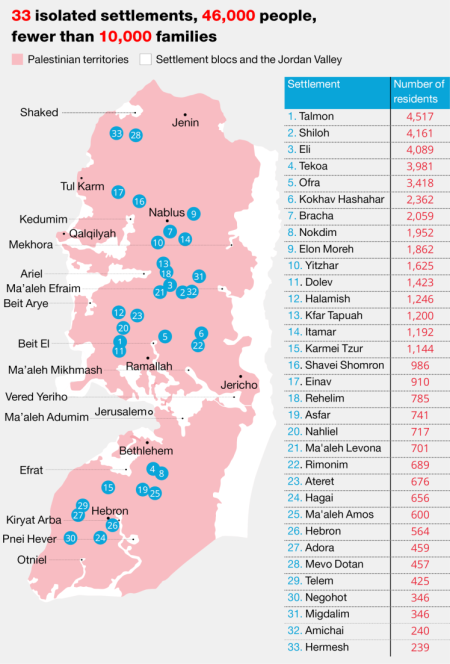
For any Israeli government it is necessary to coordinate its actions with the mainstream settler community. According Fathom approximately 590,000 Jews living beyond the Green Line can be divided into three groups. The first group is the approximate 200,000 Israelis who live in the 12 Jewish neighbourhoods of East Jerusalem, which will undoubtedly remain under Israeli sovereignty in any agreement. The second group is some 300,000 settlers who live in the so called ‘settlement blocs,’ located west of the security barrier which are usually very close to the Green Line. The vast majority of these settlements are also likely to remain under Israeli sovereignty. Only the third group, comprising 90,000 settlers – less than 20 per cent of the entire population of those living beyond the Green Line – who live beyond the route of the security barrier, needs to be addressed at the present time.
Leftist approach
The main position of the Zionist Left has been spatial separation between Israelis and Palestinians – “they are there and we are here.”One of the first plans for the West Bank was submitted by then-Labor Party minister Yigal Allon. Allon’s basic idea was to give Israel defensible borders, while not significantly altering the demographic balance of the country. His plan called for Israel to annex most of the Jordan Valley – a ribbon some 15 kilometers in width from the Jordan River to the eastern slopes of the mountain ridge running through the West Bank – to serve as a buffer from attacks from the east. Israel would annex one-third of the West Bank, and give up the other two-thirds. The densely populated Palestinian areas from the mountain ridge to the Green Line would not be annexed, and would either form a Palestinian autonomous region, or – in a later revision of the plan – be confederated with Jordan, and linked to the Hashemite kingdom by a corridor near Jericho.

Allon+ Plan, put forward in 1995 by Benjamin Netanyahu
The guiding principle of Allon plan, as well most plans after that, was to retain the maximum number of settlers inside Israel in the minimal amount of territory. This principle is valid also with Leftist plans during last years.
Former Leader of the Israeli opposition – and Labor/Zionist Union – Isaac Herzog proposed to divide the land between the Israelis and Palestinians. Following a quote from interview of Isaac Herzog in Fathom:
I speak in a very frank and open manner. I believe that Israel must move for peace. We must move towards the division of the land between the Palestinians and us in order to maintain the future of Israel as a Jewish democratic state. We will be here and you, Palestinians, will be there…Live your lives, improve your economy, create employment. The blocs under Israeli sovereignty will be part of the permanent solution. They will serve as recipients of settlers from outside the major blocs.”
Politically, the idea “us here, them there” harkens back to Yitzhak Rabin, who used that as a campaign slogan in 1992. Later former Prime Minister Ehud Olmert proposed a similar unilateral separation in the West Bank. Herzog’s plan seems likely to garner support among the centrist, center-left and even parts of the center-right Israeli voter base.
According Omer Bar-Lev ( MK for the Zionist Union)
”If Israel wants to be a democratic state, which it does, then it has to either grant them full citizenship rights, which will subsequently destroy Zionism (one state for two nations) or separate from the Palestinians (two states for two nations). In that case, Israel can keep the Zionist spirit.” His steps include a halt to settlement construction beyond the main settlement blocs, passing a compensation law in the Knesset to grant generous compensation to settlers living outside the blocs who want to settle inside Israel, expanding Area B – the territory in the West Bank where the Palestinians have civil control, and Israel has security control – by another 20%, a move that would necessitate taking 20% from Area C, and the evacuation of some 35,000 settlers living in that part of Area C. Once separation is achieved, Bar-Lev hopes the sides will negotiate a final status deal. His map has Israel ceding 95% of the West Bank, and needing to evacuate a total of 70,000 settlers.
According Israeli NGO Blue White Future Israel should prepare for a reality of two states for two people,
- by considering transferring areas east of the barrier to Palestinian control in a gradual, monitored and supervised manner. [Note that this part requires coordination and therefore is optional].
- by enacting a law that allows for voluntary evacuation, compensation and eventual absorption of settlers presently residing on the eastern side of the security barrier, to encourage settlers who wish to relocate within the green line or within settlement blocs, regardless of whether an agreement with the Palestinians is concluded. and
- by preparing a national plan for the absorption of the settlers who would relocate to Israel proper, whether before or after an agreement is signed. Such a plan should have urban, vocational, social, psychological and other appropriate components.
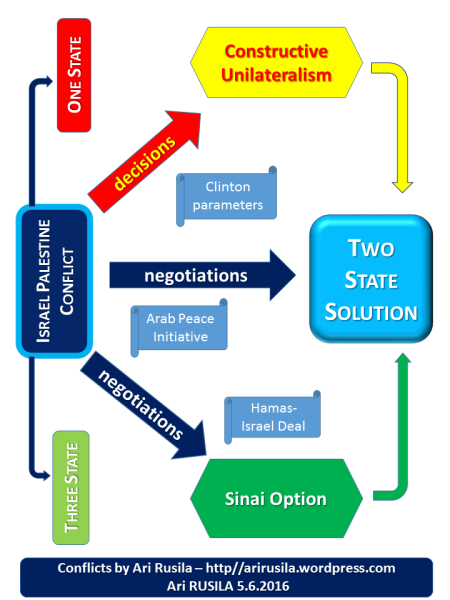
Some alternatives?
The alternative plans from the Right range from extending Israeli sovereignty over all of Judea and Samaria and encouraging the Palestinians there to leave, to annexing Area C, and giving the 80,000 Palestinians living there Israeli citizenship.
On the far Right of the spectrum is a plan articulated by former Likud MK Moshe Feiglin, who advocates a plan for Jewish sovereignty over Judea and Samaria that includes the following: Annexing all of Judea and Samaria and making sure that Jewish sovereignty extends everywhere. The Arab population would have the following options: Either emigrate voluntarily with the aid of a “generous emigration grant”; receive permanent residency – similar to Green Card status in the US – but be unable to vote.
A different approach has been proposed by Defense Minister Avigdor Liberman. Liberman advocates taking all of the land – excluding Gaza – from the Mediterranean to the Jordan and redividing it along demographic lines. In this plan, large Jewish settlement blocs would be drawn into Israel, and the area of the “Triangle” with its large Israeli Arab population would be penciled into a Palestinian state.
In addition there is the maximalist alternative plans from the Right – annex all of the territories Israel gained during the Six Day War – and also the maximalist plans of the Left: a complete withdrawal from all the territories. Few Israelis, nor I, advocate such a policy, so over the years there have been numerous variations on this theme.
Recently a new approach to the Jewish-Arab/Palestinian conflict was proposed by sc Federation Movement Its Federation Plan or Federation Program presents a new approach to the Jewish-Arab/Palestinian conflict. The basic idea is
formulation of a common vision for the federal state by establishment of a federal government, and the division of the country into 30 cantons, 20 of which will have a Jewish majority and ten will have Arab majorities (one of which will have a Druze majority). At first place the federation idea sounds interesting as it seems to solve a basic dilemma in Israeli-Palestinian conflict: how Israel same time can survive as a Jewish state, have real democracy and keep – more or less – post-1967 boundaries especially in West Bank.
My View
The final status agreement has been very close at least since Beilin-Abu Mazen understandings/agreement/plan (1995) where nearly all issues were agreed; The Olmert proposal (2008) was probably the last serious try. (both plans can be found from my document library ) The parameters of the end-game have been clear the whole time but despite of a number of negotiations the final agreement is missing.
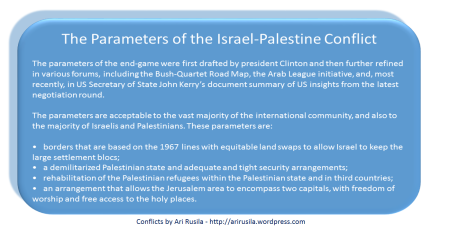
As possible solutions for Israeli-Palestinian conflict there has been besides 2-State solution also bi-national ‘One-State’ solution, partial solutions like Sinai and Jordan Options and different variations of ‘Three States’ solutions. One of course easy ‘solution’ is zero-option – ‘frozen conflict’ or ‘status quo’ scenario which can be implemented also through pseudo-talks. Today also unilateral actions – instead vain negotiations – can pave way towards some solutions.
In my opinion democratic One-state, Israel-Palestine federation or confederation based on cantons might work in theory but not in practice at least for decades. My argument is that even since early times of British Mandate first the Pan-Islamic and then pan-Arab rhetoric expressed fundamental ethnic and religious objections to Jews and for the establishment of a Jewish national home in Palestine. The history of repeated aggressions by neighbours have also created deep distrust among Jews about Palestinians. This kind of ecosystem and peoples’ minds are challenging to transform peaceful coexistence with eternal enemy; it might take decades and generations to change fundamental ethic values. Besides instead of Israel-Palestine federation or confederation I see Palestine-Jordan confederation much more better model.
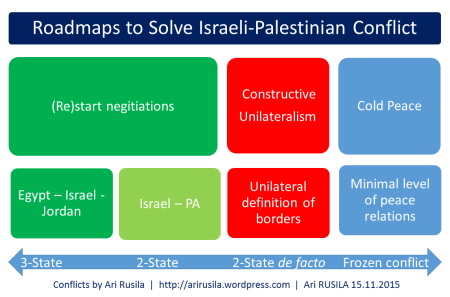
I referred two new leftist initiatives above and in my article Constructive Unilateralism: Leftist Approach to Israel-Palestine Conflict – ‘it’s in our hands’ by Omer Bar-Lev, an MK for the Zionist Union and ‘Constructive unilateralism’ by Blue White Future, leftist think tank – which both in my opinion are steps forward and also to the right direction as well including required new roadmap for better future. I don’t see constructive unilateral steps as goal but more as strategy and process which will lead towards a comprehensive agreement.
The new analysis by Haaretz (How Many Settlers Need to Be Evacuated to Make Way for a Palestinian State ) gives some content for implementing these possible Leftist plans in West Bank.
Related articles:
Peacemaking – a Holistic Approach
Israeli-Palestinian Conflict: A Revised Hybrid Model as Solution
Palestinians Put Jordanian Option on the Table
Israel-Palestine Conflict: Regional Approach
Israel’s 5 Strategy Options Regarding West Bank After Abbas
Trump Presidency Brings Realpolitik Back To Mid-East
Constructive Unilateralism (II) as Solution to Israeli-Palestinian Conflict
Herzog’s Plan: Security Barrier Around the Major Settlement Blocs of West Bank
Analysis: Resolving The Israeli-Palestinian Conflict
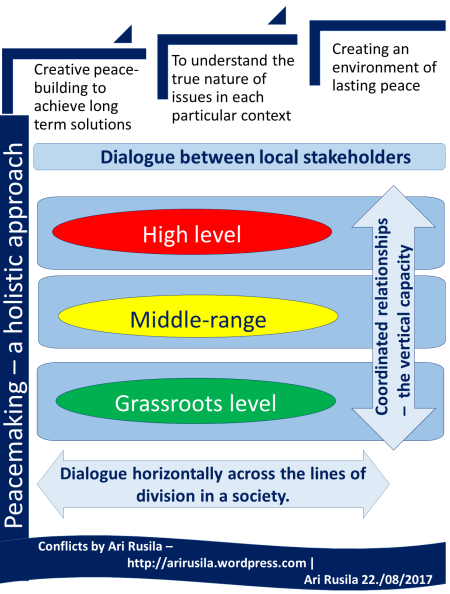
The ideal – maybe utopist – long holistic peace process by Ari Rusila
Advertisements
